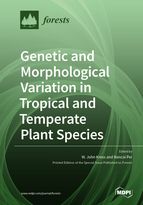Genetic and Morphological Variation in Tropical and Temperate Plant Species
A special issue of Forests (ISSN 1999-4907). This special issue belongs to the section "Forest Ecophysiology and Biology".
Deadline for manuscript submissions: closed (15 March 2019) | Viewed by 76061
Special Issue Editors
Interests: biodiversity genomics; DNA barcoding; plant-animal interactions; conservation; The Anthropocene; Zingiberales
Special Issues, Collections and Topics in MDPI journals
Interests: urban forestry; forest biology
Special Issues, Collections and Topics in MDPI journals
Special Issue Information
Dear Colleagues,
Plants provide the foundation for the structure and function, as well as interactions, among organisms, in both tropical and temperate zone habitats. To date, many investigations have revealed patterns and mechanisms generating plant diversity at various scales and from diverse ecological perspectives. However, in the era of climate change, anthropogenic disturbance, and rapid urbanization new insights are needed to understand how plant species in these forest habitats are changing and adapting. Investigations of plants in both little-disturbed, more natural environments, as well as in urban areas in which crucial green infrastructure is ever more important for sustaining complex human societies are needed. This Special Issue of Forests will focus on plant variation from the perspectives of morphology, genetics, and function, especially plant interactions with biotic and abiotic factors. Research articles may address any aspect of plant evolution and community phylogenetics (explorations of patterns and mechanisms from diverse organismal levels, e.g., molecular, population, species, community, landscape, and ecosystem), plant functional traits (e.g., nutrient traits of leaf, stem, root; reproductive traits of flower, fruit, seed), and/or responses of plant species to changing environments (e.g., water, atmosphere, soil, human activities). Studies providing quantitative evaluation or description of interactions of plants with animals and microbes, both in natural and urban environments, including terrestrial and aquatic systems, are also welcome.
Dr. W. John Kress
Dr. Nancai Pei
Guest Editors
Manuscript Submission Information
Manuscripts should be submitted online at www.mdpi.com by registering and logging in to this website. Once you are registered, click here to go to the submission form. Manuscripts can be submitted until the deadline. All submissions that pass pre-check are peer-reviewed. Accepted papers will be published continuously in the journal (as soon as accepted) and will be listed together on the special issue website. Research articles, review articles as well as short communications are invited. For planned papers, a title and short abstract (about 100 words) can be sent to the Editorial Office for announcement on this website.
Submitted manuscripts should not have been published previously, nor be under consideration for publication elsewhere (except conference proceedings papers). All manuscripts are thoroughly refereed through a single-blind peer-review process. A guide for authors and other relevant information for submission of manuscripts is available on the Instructions for Authors page. Forests is an international peer-reviewed open access monthly journal published by MDPI.
Please visit the Instructions for Authors page before submitting a manuscript. The Article Processing Charge (APC) for publication in this open access journal is 2600 CHF (Swiss Francs). Submitted papers should be well formatted and use good English. Authors may use MDPI's English editing service prior to publication or during author revisions.
Keywords
- tree genetics
- plant morphology
- forest biodiversity
- plant traits
- plant-animal interactions
- environmental change







